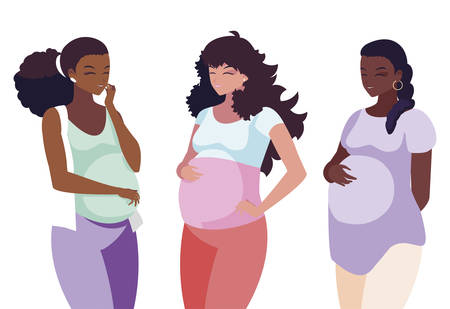What Are Braxton Hicks Contractions?
Braxton Hicks contractions, often called “practice contractions,” are a normal part of pregnancy, especially as you move into your second trimester. Many moms-to-be in the U.S. start to notice these mild and irregular tightenings of the uterus sometime after week 20. While they can be surprising or even a bit uncomfortable, understanding them can help ease any worries.
What Exactly Are They?
Braxton Hicks contractions are your body’s way of getting ready for labor—even though real labor is still weeks or months away. Think of them as warm-up exercises for your uterus. These contractions help tone your uterine muscles and increase blood flow to the placenta, making sure both you and your baby are prepared for the real thing when the time comes.
Why Do Braxton Hicks Contractions Happen?
There isn’t one single reason why Braxton Hicks contractions occur, but experts believe they serve a few important roles during pregnancy:
- Preparation for Labor: They help your uterus practice contracting, which will be important when it’s time to give birth.
- Improved Blood Flow: The squeezing action can boost circulation to your placenta and baby.
- Toning Uterine Muscles: Just like working out other muscles, these gentle contractions help keep your uterus strong.
Braxton Hicks vs. Real Labor Contractions
| Feature | Braxton Hicks Contractions | Real Labor Contractions |
|---|---|---|
| Timing | Irregular, unpredictable | Regular, get closer together over time |
| Pain Level | Mild, more uncomfortable than painful | Usually stronger and more intense |
| Location | Mainly in the front of the belly | Often starts in back and moves to front |
| Effect on Cervix | No changes to cervix | Cervix begins to dilate and thin out (efface) |
| Response to Movement/Rest | Often stop with movement or hydration | Keep going no matter what you do |
If you’re ever unsure whether what you’re feeling is just Braxton Hicks or something more serious, it’s always okay to reach out to your healthcare provider—they’re there to support you every step of the way!
2. Common Signs and Sensations in the Second Trimester
What Do Braxton Hicks Contractions Feel Like?
During the second trimester, many expectant moms start to notice new sensations as their bodies change and prepare for labor. Braxton Hicks contractions are one of these early signals. They are often described as a tightening or hardening of the belly that comes and goes. Unlike true labor contractions, Braxton Hicks are usually painless, but they can feel a bit uncomfortable or strange.
Typical Experiences Shared by Moms
Every pregnancy is unique, but here’s what many women in the U.S. report feeling when experiencing Braxton Hicks during the second trimester:
| Sensation | Description | How Long It Lasts |
|---|---|---|
| Tightening of the Abdomen | The stomach feels hard or tight for a short period, then relaxes. | 30 seconds to 2 minutes |
| Mild Discomfort | A sensation similar to light menstrual cramps, but not painful. | Short-lived and irregular |
| No Regular Pattern | Braxton Hicks do not come at set intervals; they’re unpredictable. | Can occur a few times a day or week |
| Relieved by Movement or Hydration | The sensation often eases if you change position or drink water. | Goes away quickly after self-care steps |
How to Tell Braxton Hicks from Other Sensations
The second trimester brings all sorts of changes. You might feel stretching, aches, or even mild cramps as your baby grows. Here’s how you can tell if what you’re feeling is likely Braxton Hicks rather than something else:
| Braxton Hicks Contractions | Other Sensations (e.g., True Labor, Round Ligament Pain) |
|---|---|
| Irregular timing No set pattern Often go away with rest or hydration Mild discomfort but not real pain No increase in frequency or intensity over time |
Regular and increasing in strength (true labor) Sharp pains on one side (round ligament pain) Don’t ease with movement or drinking water Accompanied by other symptoms like bleeding or severe pain Progressively get closer together and stronger (if labor) |
When to Call Your Healthcare Provider
If you experience regular, painful contractions, have any vaginal bleeding, leaking fluid, or feel concerned about what you’re experiencing, it’s important to call your doctor or midwife right away. In most cases, Braxton Hicks are harmless and just a normal part of pregnancy in the U.S., but it’s always best to check if you’re unsure.

3. How Braxton Hicks Differ from True Labor
During pregnancy, it’s common for moms-to-be to feel tightening or cramping in their belly, especially as they move through the second trimester. These feelings can be confusing—are they just Braxton Hicks contractions or could they mean real labor is starting? Here’s how you can tell the difference and know what signs to watch for.
Understanding the Differences
Braxton Hicks contractions are sometimes called “practice contractions” because your body is getting ready for labor, but these aren’t the real deal. True labor contractions, on the other hand, signal that your baby may be on the way soon. Knowing the key differences can help you feel more confident and less anxious during this special time.
Main Differences at a Glance
| Feature | Braxton Hicks Contractions | True Labor Contractions |
|---|---|---|
| Timing | Irregular and unpredictable; no consistent pattern | Regular intervals, gradually getting closer together |
| Intensity | Mild to moderate discomfort; doesn’t get stronger over time | Starts mild, but gets stronger and more intense with each contraction |
| Duration | Usually lasts less than 30 seconds to 2 minutes; varies a lot | Lasts about 30-70 seconds each and becomes longer over time |
| Location of Pain/Pressure | Mainly felt in the front of the belly or lower abdomen; doesn’t radiate | Starts in lower back and moves to the front of the belly, often radiates down legs or pelvis |
| Change with Movement or Position | Often goes away if you change positions, drink water, or rest | Keeps going no matter what you do; changing position doesn’t help much |
| Cervical Changes (doctor checked) | No changes to cervix (doesn’t open or thin out) | Cervix begins to dilate (open) and efface (thin out) |
| Associated Signs | No other signs of labor like bleeding or water breaking | May include bloody show, water breaking, or other early labor symptoms |
What Should You Watch For?
If your contractions are irregular, mild, and go away when you rest or hydrate, they’re probably just Braxton Hicks. But if they start coming regularly, get stronger over time, or come with other signs like leaking fluid or bleeding, it might be time to call your healthcare provider. Remember—every pregnancy is different! When in doubt, trust your instincts and reach out to your doctor or midwife for reassurance.
4. When to Call Your Healthcare Provider
If you’re experiencing Braxton Hicks contractions during your second trimester, it’s normal to wonder when you should reach out to your doctor or midwife. Most of the time, these “practice contractions” are nothing to worry about. However, there are certain signs and symptoms that mean you should get in touch with your healthcare provider right away.
Warning Signs That Need Immediate Attention
Not all contractions are harmless. Here’s a quick guide to help you know when it’s time to call your provider:
| Symptom | What It Could Mean | What To Do |
|---|---|---|
| Painful, regular contractions (every 10 minutes or less) | Possible preterm labor | Contact your healthcare provider immediately |
| Vaginal bleeding or spotting | Could be a sign of complications | Call your provider as soon as possible |
| Leaking fluid from the vagina | Possible ruptured membranes (water breaking) | Seek medical attention right away |
| Severe lower abdominal pain or cramping | Could indicate something more serious than Braxton Hicks | Contact your provider for evaluation |
| A decrease in fetal movement | Your baby may not be getting enough oxygen or nutrients | Let your provider know as soon as possible |
| Fever, chills, or feeling very unwell | Possible infection or other health issue | Reach out to your provider promptly |
| Pain or burning when urinating with contractions | Might be a urinary tract infection (UTI) | Call your provider for advice and treatment options |
When to Play It Safe and Call Anyway
If you’re ever unsure about what you’re feeling, it’s always okay to contact your healthcare team. They would much rather answer questions and reassure you than have you worry at home. Trust your instincts—if something feels off or different from what you’ve read or been told is typical for Braxton Hicks contractions, don’t hesitate to reach out.
5. Tips for Comfort and Self-Care
Simple Ways to Stay Comfortable During Braxton Hicks Contractions
Braxton Hicks contractions in the second trimester can catch you off guard, but there are some easy steps you can take to help yourself feel more comfortable. Here are some practical tips that many moms-to-be in the U.S. find helpful:
Change Positions
If you’re sitting, try standing up and walking around. If you’ve been on your feet, take a break and sit or lie down. Changing positions can often ease the tightening feeling.
Stay Hydrated
Dehydration is a common trigger for Braxton Hicks contractions. Make sure you’re drinking enough water throughout the day. Aim for at least 8-10 cups daily unless your healthcare provider advises otherwise.
Practice Relaxation Techniques
Try deep breathing, gentle stretching, or prenatal yoga. These techniques can help relax your muscles and calm your mind during uncomfortable moments.
Take a Warm Bath or Shower
A warm (not hot) bath or shower can soothe your body and may help lessen contractions.
Use a Supportive Pillow
Body pillows or pregnancy pillows can offer extra support when sitting or lying down, making it easier to find a comfortable position.
Lifestyle Adjustments That May Help
| Lifestyle Tip | How It Helps |
|---|---|
| Rest Regularly | Taking short breaks throughout the day gives your body time to recharge and may reduce the frequency of contractions. |
| Avoid Heavy Lifting | Lifting heavy objects can trigger contractions—ask for help when needed. |
| Eat Balanced Meals | Regular, nutritious meals help maintain energy and overall well-being during pregnancy. |
| Wear Comfortable Clothing | Loose-fitting clothes put less pressure on your belly, helping you stay comfortable as your body changes. |
| Monitor Your Activity Level | If certain activities seem to bring on contractions, try scaling back and see if it makes a difference. |
When to Try These Tips?
You might notice Braxton Hicks more after physical activity, when you’re tired, dehydrated, or at the end of a busy day. That’s a good time to pause and use these comfort tips. Always listen to your body—if anything feels off or if contractions become painful or regular, reach out to your healthcare provider right away for advice.


